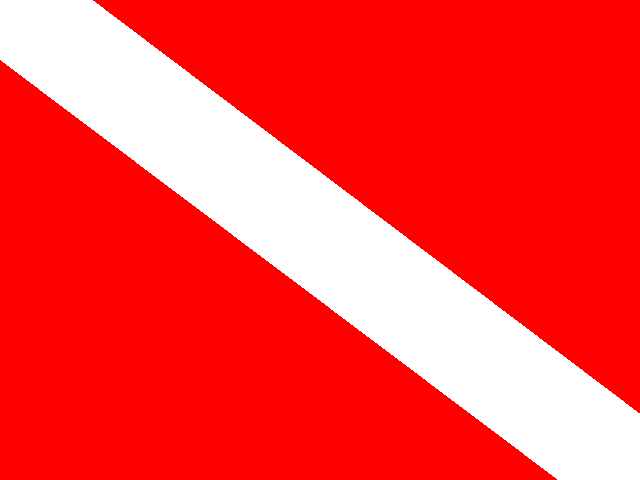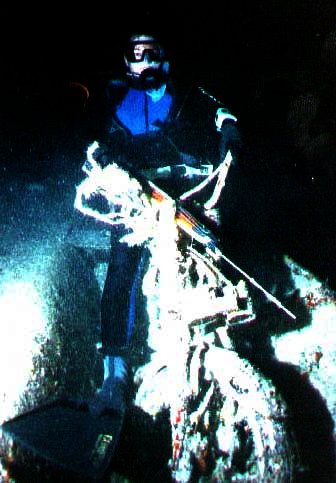 Phil's Diving Page
Phil's Diving Page 
 Phil's Diving Page
Phil's Diving Page 
Yupp, it's me, on a South Florida wreck. |
I love SCUBA diving!!! |
| My favorite places to dive, so far, are South Florida and off the coast of my home state, North Carolina. While most divers are very familiar with what Florida has to offer, they don't know much about NC. The wreck diving here is better than incredible. And we've got some pretty sweet ledge diving too. |
 Photo by Mike Albin Photo by Mike Albin |
There are three main reasons the wreck diving here is so great. The oldest sources of North Carolina shipwrecks are Cape Fear, with it's Frying Pan Shoals on the south end of the state, and Cape Hatteras, with Diamond Shoals jutting out off the north end of the state. These two major shoals extend far out into the Atlantic, well beyond sight of land. Their treacherous shallows have claimed vessels since the earliest sailors entered these waters. In combination with the fierce storms that rake this coast, the shoals earned North Carolina's waters the nickname "The Graveyard of the Atlantic."
Another source of shipwrecks off the NC coast was the Civil War, AKA "the War of Northern Aggression". . .or, "The Recent Unpleasantness." The Cape Fear River, along with other coastal inlets and rivers, served as important ports for Confederate supply ships, especially during the Union Blockade. The Blockade Runners, swift, stealthy, and shallow draft ships, often slipped through the Union line, bringing in much needed munitions and other supplies for the Southern forces. Sometimes, though, the Blockade Runners were either not swift or stealthy enough and were caught and sunk by Union warships; or they misgauged the channels and ran aground. At any rate, the nearshore waters around the Cape Fear river mouth offer dozens of these vessels to the shallow water wreck diver. Some are hard to find, and others are marked on the navigation maps. Besides the Blockade Runners, the Civil War claimed a few other vessels off this coast as well. Perhaps the most famous is the ironclad, Monitor, which sank in a storm off Cape Hatteras. This is a deep dive, but very popular among hard core tech divers.
The third source of North Carolina's shipwrecks was World War II. During the early months of the war, German U-Boats prowled the East Coast of the US with relative impunity, sinking more tonnage in a few months than the US forces sank in the entire Pacific war. Many of these ships were sunk off NC, as they had to sail farther offshore to round the previously mentioned shoals. A weak coastal defense system, and what appear to be some major beaurocratic snafus, allowed this predation to reach such an extent that the area became known as the "Atlantic Turkey Shoot." Due to the fright and confusion surrounding the attacks, many other ships sank from friendly mines, or ran aground on the shoals. Still others accidentally rammed one another, since they often ran at night without lights. With all the damage done by the German U-boats, only 9 of the enemy submarines were destroyed. One of the last to sink, the U-352, went down off of Morehead City, NC, and is an excellent dive site today.
North Carolina's artificial reef program has also provided some excellent diving opportunities, many within a couple of miles of the beach. While the inshore diving doesn't offer the great visibility common to South Florida's waters, the variety and quality of dive sites certainly compares favorably. And when you get out to about 20 miles from shore, the visibility and almost year round warm (mid-60's) water might just make you think you are down in the little latitudes.
The diving scenery is plenty spectacular in itself. But if you're a hunter, like me, the spearfishing and lobstering opportunities also make the area a real paradise. Big grouper and hogfish, as well as plenty of snappers and other fish are common on many dive sites off the NC coast. Lobsters also grow pretty healthy here. A five to seven pound spiny is not too unusual. And the slipper lobsters, or shovelnose, aren't too hard to find either. There is no special license required in NC, and because the bugs are found outside of state waters, federal regulations dictate limits, seasons, and manner of taking.
Since July of '96, I have been living near the coast of Northern California, and I've found the diving to be QUITE a different experience. The water is cold, the fish are generally ugly, and the ocean is rough. This said, I love it. I'm the kind of diver who's happy just to be breathing out of a regulator. And the kelp beds are pretty cool, when you can see them at all. Like diving in the forest, and swooping down from the canopy on the unsuspecting creatures below. Of course, sometimes things swoop down on you from the canopy, such as sea lions and otters, and perhaps the occasional shark. All in all, and given my so far limited experience, it'll do. But I still dream of the warm blue of my home waters. More to come on this. . .
Copyright 1997 Elwing Enterprises
All text and photos by Elwing Enterprises unless otherwise noted
Last revised: August 24, 1998.